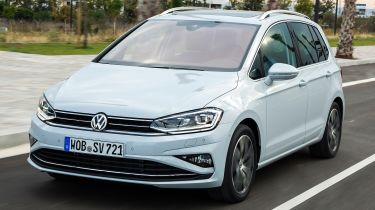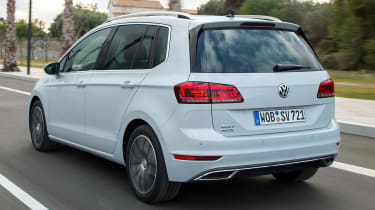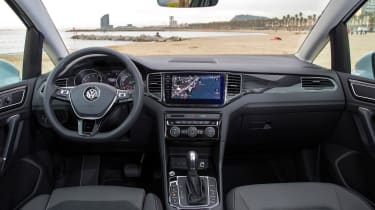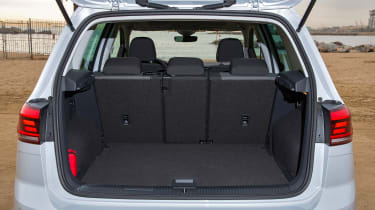New Volkswagen Golf SV 2017 review
The more practical Volkswagen Golf SV still has its work cut out prising families out of their crossovers

This mid-life facelift does just enough to keep the Volkswagen Golf SV fresh, but its biggest failing remains its frumpy MPV body. Crossovers and SUVs are climbing up the sales charts for good reason, as they’re nearly as practical but infinitely more desirable than MPV-style equivalents. Even with a rational hat on, the SV remains a hard sell.
When was the last time you saw a Volkswagen Golf SV? Chances are you can’t recall it – the firm has sold fewer than 13,000 in the UK since the SV launched in 2014. For context, Ford sells around 7,500 Fiestas every month; around 90,000 units per year.
It’s a different story in the SV’s home market, however. Over 150,000 have found homes with German owners, and despite the rise of the SUV, that success looks set to continue. To see if we’re missing a trick, we’ve been out in Spain to drive the facelifted car, ahead of its dealer launch in December.
• Best MPVs and people carriers to buy now
The changes on the Golf SV broadly follow the updated Golf hatchback, which was revised wholesale earlier this year. That means a similar set of headlamps, new bumpers and LED tail-lights, as well as new engine options, extra equipment and a suite of improved safety technology.
It’s blink-and-you’ll-miss-it stuff on the outside, however. Those new headlamp clusters are subtly updated for 2017, but now feature LED daytime running lights across the range. There are five new alloy wheels designs, as well as a new Cranberry Red paint colour. Inside, there’s new trim, fabrics and leather seats, as well as VW’s updated infotainment system.
Used - available now

2022 Ford
S-Max Vignale
6,476 milesAutomaticPetrol2.5L
Cash £30,496
2021 Vauxhall
Astra Sports Tourer
41,054 milesManualPetrol1.2L
Cash £10,995
2017 Toyota
Yaris Hybrid
22,510 milesManualPetrol1.5L
Cash £11,104
2023 Ford
Focus Estate
19,162 milesManualPetrol1.0L
Cash £18,847The SV is just as practical as before; it’s slightly bigger than a Golf hatch, but smaller than a Golf Estate. The 500-litre boot expands to 590 litres (vs the Estate’s 605 litres) with the rear seats slid forward, while folding them flat reveals a 1,520-litre load bay – 100 litres shy of the Golf wagon. Its raised driving position gives a more commanding view of the road, but a Tiguan is higher still, and comes in a more fashionable SUV body.
Space in the back is good, however, and the sturdy tray tables will prove handy for those with small children. The high roofline means you can happily fit taller adults in the rear, though three across the back may prove a squeeze. Up front, you’ll notice the same, logically laid out and beautifully built cabin as in the latest Golf hatchback; it’s smart, but fairly conservative in its design.
The new infotainment system is crisp and responsive, and comes packed with technology. The basic 6.5-inch screen has been upgraded to an eight-inch setup, while the latest (and optional) Discover Navigation Pro system uses a crystal clear 9.2-inch screen. The new Golf SV also gets Front Assist and Pedestrian Monitoring as standard, as well as optional kit like Adaptive Cruise Control and Traffic Jam Assist. The firm’s up-to-date Park Assist system debuts on the SV, too.
Also new is the 1.5-litre TSI Evo engine as tested here. It replaces the old 1.4 TSI and joins the three-cylinder 1.0-litre petrol units, while a range of 1.6 and 2.0-litre diesels will arrive in the New Year. The 1.5 Evo engine is available in two outputs (128bhp or 148bhp) and it’s the lower-powered car we’re trying. VW reckons this model will be the best seller, with the seven-speed DSG likely to appeal to more buyers than the standard six-speed manual box.
It’s a relatively punchy performer, picking up speed efficiently and without much drama. It’s remarkably refined, in fact, emitting barely a whisper at idle and very little in the way of wind or road noise at motorway speeds. Rev it out and it’s a little coarse, but this isn’t the kind of car you’ll want to hustle down a winding B-road. While it never feels sloppy, the steering is light and there isn’t much feel through the wheel.
• Best crossovers and small SUVs
Body roll is well contained, however, and the DSG box shifts smoothly and without hesitation. Our car did without the optional Dynamic Chassis Control (DCC) system, though the standard passive dampers work well, offering a compliant ride on all but really rough surfaces.
It’s worth noting that by neglecting to include a BlueMotion version of the 1.5 Evo TSI 130 engine in the SV, Volkswagen has ensured that it misses out on the standard Golf’s clever coasting function. In the hatchback, the unit can actually shut down all four cylinders to save fuel. That shouldn’t matter to many buyers, however, as the SV still manages more than 50mpg, with acceptable CO2 emissions, as well.











